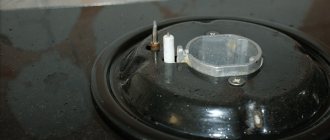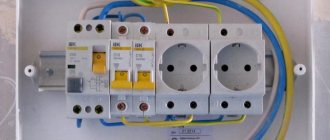A properly functioning fluorescent lamp lights up immediately after switching on. Blinking once or twice during startup is allowed: this happens as a result of igniting the gas. However, if the fluorescent lamp blinks during operation or the flickering at the start is too long, there is reason to think about the serviceability of the device.
In addition to blinking, symptoms of problems include extraneous sounds made by the lamp, including crackling or humming.
Types of ballasts and features of the electromagnetic choke
There are two types of ballasts: electromagnetic choke and electronic ballast. Each system has its own disadvantages and advantages.
The electromagnetic choke is inexpensive, easy to install and control. Its main disadvantages are great noise and fragility. It is also worth noting that 25% of the power is spent on electromagnetic ballast, as a result of which the efficiency is significantly reduced.
An electromagnetic choke is installed less and less today. But it will also suit you if there are no excessive requirements for the quality of lighting in the room. Moreover, if you choose a good quality throttle (Osram, Philips or Eurosvet), it will serve you for a long time.
Why do lamps that are turned off flicker?
Before looking for the answer to this question, it is necessary to consider the design of the LED lamp. Despite the fact that it is connected to a network that supplies alternating current, its operating state is maintained constant. In addition, LEDs can operate at voltages less than 220 V.
The design of such lamps includes a device called a driver. It changes alternating current to direct current, simultaneously reducing the voltage. In the place where the input to the driver is located, 4 diodes are located. Electrolytic capacitors are responsible for leveling out the ripples that occur during the conversion of alternating current to direct current. Similar components are used in rectifiers. The voltage is supplied to a capacitive filter, after which it is supplied to an electrical circuit, which converts it and stabilizes the output.
Often the reason that explains the flickering of a switched-off lamp is backlit switches. The latter regularly supplies current to the LED. That is, when the switch is on, electricity flows directly through the contact system, and after it is turned off, it goes through a neon light bulb built into the structure. This light bulb operates under a low load, through which current, in turn, flows.
Gradually, the energy passing through the LED rectifiers charges the capacitor installed in the LED lamp. As the voltage accumulated due to the process described above increases, the amount of voltage reaches a value sufficient to trigger the LED. At the moment the flash occurs, the capacitors are completely discharged, and in the future this process is repeated again. The frequency of occurrence of the described phenomena depends on several parameters of the LED lamp, including the capacity of the built-in capacitor and its power.
Parsing the circuit
Everything is quite simple here. A voltage of 220 volts is supplied from the AC mains to the diode bridge through a fuse. It is designated “F1” in the diagram. After the diode bridge, a constant current with a certain small ripple comes out. To smooth out the ripple, a capacitor is installed in the circuit. It is designated as "C4".
Energy saving light bulb in electrical circuit
So this capacitor is the very reason, mind you, the main reason why the energy-saving lamp blinks after being turned off. True, this is not the only reason why these lighting devices blink after being turned off, so let’s look at them all in order.
Reason #1 – switch illumination
To quickly find the switch at night, manufacturers install neon bulbs or LEDs on them. It is convenient from all sides. So the backlight is connected in parallel to the contacts of the switch itself. Moreover, any electrical circuit has a certain resistance. In our case, with an LED it is 100 kOhm with a power of only one watt, with neon backlighting it is 1000 kOhm and a power of 0.5 to 1.0 W.
So why is the light blinking? The thing is that when the switch is on, the current load goes entirely to the energy-saving lamp through the contacts. Once the switch is turned off, the circuit connecting the lamp and the network is broken. But a small bridge in the form of LED (neon) lighting remains. The current passing through it has a small load value, but it is enough to charge the filter capacitor in the lamp connection circuit.
The backlight of the switch may be one of the reasons for the blinking of the switched off light bulb
As soon as the capacitor collects the required amount of electricity, it will begin to try to turn on the circuit of the lamp itself. But its charge is not enough for this. That is, I collected a charge, gave it to the lamp, discharged, and again it takes time to charge. But in reality it turns out that the energy-saving light bulb blinks all the time.
What to do
- The easiest option is to remove the switch backlight by disconnecting the connecting wires between the contacts and the backlight source.
- If the switch operates on several light sources at once, it is recommended to replace one energy-saving lamp with a regular incandescent light bulb. In this case, a small current passing through the neon or LED will be spent on heating the filament. But this current is not enough, so nothing will blink.
- If the switch only works for one energy-saving lamp, but you do not want to change it, then you can install it in parallel directly in the chandelier with a resistance of 50 kOhm and 2 W. Essentially, this resistance will perform the functions of an incandescent lamp. Let's face it - it's a crazy idea that shouldn't even be used; it's better to buy a switch without backlighting.
Reason No. 2 – incorrect installation
What does incorrect installation mean? This is when the switch is supplied not with phase, but with zero. That is, the light source will always be under low voltage. In any case, it will be enough to recharge the capacitor. In this case, there is only one way out - to swap the phase and zero in the switchboard.
I would like to add that the energy-saving lamp will blink even if the wiring in the house is in poor condition. What to do in this case? There are two options here:
- Change all wiring. This is long and costly, in any case, you will have to wait for the next major overhaul. Although it is possible to carry out the replacement in an open way.
- Install an RCD and ground the network in sections.
Reason #3 – poor quality
The third reason why an energy-saving lamp blinks is its low quality. To be honest, there are a huge number of energy-saving lamps on the market that do not meet state standards. These are not only Chinese-made devices, domestic manufacturers are also guilty of this. Therefore, these devices installed in the home lighting network sometimes not only blink, they simply do not light up.
Therefore, my advice is to purchase lamps only from branded manufacturers who have proven the reliability and high quality of their products. Although it should be noted that such manufacturers also have defects. So no one is immune from this.
Why does the energy-saving light bulb blink when the switch is turned off? Reasons
Energy-saving lamps are a worthy replacement for conventional incandescent lamps. But, despite many positive qualities, they have a number of negative ones. The most common is the flickering of the lamp after the switch is turned to the “off” position.
Main reasons:
- Malfunction of the lamp itself;
- Incorrect connection;
- Lighting in the switch.
Today, there are a huge variety of energy-saving lamps. They differ in different parameters, one of which is price. Trying to save money, many people do not take into account such important features as the manufacturer and warranty when purchasing. When choosing the cheapest options, it is often discovered that the lamp is faulty even before work begins, and this is followed by additional waste of money. To avoid this, choose trusted manufacturers. Also, a malfunction of the lamp itself may appear after a long time of operation or a power failure. Fixing the problem is quite simple - replace the non-working lamp with a new one.
Flickering can also be caused by incorrect electrical installation. This means that the switch in the circuit with the lighting device in which the flickering occurs does not interrupt the phase, as usual, but the zero. This problem can be easily resolved. If you have basic knowledge of electrical installation, you can do this work yourself. If you don’t have the skills, you can call a professional for this.
Due to the design features of the switch and the operating principle of the energy-saving lamp, flashing occurs. It happens this way. When the lighting is turned off, electricity stops flowing to the lamp and is supplied directly to the LED. A certain charge accumulates in the capacitor and after discharge the lamp flashes. There are several ways to correct the situation. Disconnecting the LED from the power circuit will also help by replacing all backlit switches with regular ones without backlight.
Reason two: electrical installation error
If an energy-saving lamp blinks when the light is off, this may indicate an error that was made during the electrical installation. Why this happens is not difficult to understand - quite often the switch breaks not the assigned phase, but zero. You can check the correct connection yourself if you have special tools, such as a voltage indicator or an electrical clamp. If you have certain skills in working with electricity, you can independently change the phase with zero in the electrical panel of your apartment - then the problem will go away.
- follow safety rules when working with electricity
- take into account the general condition of the wiring
Why does an incandescent light bulb blink?
The main reasons for the blinking of incandescent lamps in an apartment are poor-quality contacts in the circuit or faulty electrical wiring and equipment. Before trying to eliminate the cause of the lamp blinking, it is necessary to identify some features that cause it to occur.
Main reasons:
- The lamp connected to the socket blinks;
- Flashing occurs in the lighting fixture connected to the key switch;
- Lights flicker throughout the entire apartment or in one room.
A flashing portable lamp that is powered from an outlet must be checked for functionality by connecting it to different outlets, the reliability of which you are absolutely sure of. The lamp has stopped blinking, a certain socket is faulty. If the blinking continues, you should disassemble the lamp, check and, if necessary, clean the contacts.
If the lamp(s) in the lighting fixture connected to the key switch blinks, then most likely the lamp itself or the wiring section is faulty. First of all, replace the flashing lamp with a working one. If this does not help, you need to check the switch contacts or ring the wiring going from the switch to the lighting fixture.
Flickering of light throughout the apartment or in a certain room indicates several reasons. If the lighting is not stable not only in your home, but also in nearby houses, and flickering occurs in all rooms, then there are two reasons for the malfunction. Poor quality supply of electricity by the supplier company or malfunction of power equipment. If everything is flashing in only one room, this indicates an uneven distribution of electricity in the apartment.
Over the past couple of decades, a movement that cares about preserving the environment on our planet has become very fashionable. But such fighters often encounter completely unexpected problems and try to find out why an energy-saving lamp blinks when the light is turned off, how the stroboscopic effect affects human vision, why there is mercury in fluorescent lamps. What can I say, sometimes you have to pay for your desire to help the planet.
Household repair No. 1
Choose reliable craftsmen without intermediaries and save up to 40%!
- Fill out the application
- Receive offers with prices from masters
- Select performers by price and reviews
Post a task and find out prices
In the last few years, energy-saving lamps have replaced conventional incandescent light bulbs. More economical, they have become a common light source with their own advantages and disadvantages. Among the latter, it is worth noting that one of the most common problems is that the energy-saving lamp blinks when the light is off. Such ambiguous behavior for a light bulb naturally causes excitement. There are three reasons why this happens, and each has its own solution.
The device of fluorescent lamps
The glow in a fluorescent lamp occurs due to an arc discharge between two opposing electrodes. Inside the flask there is a gaseous environment where an inert gas is mixed with mercury vapor. The generated radiation remains invisible to the human eye until it is converted into visible light due to the luminescence effect. This reaction is a non-thermal glow of a substance that occurs as a result of its absorption of energy received from outside. The inner walls of the flask are coated with a phosphor that absorbs ultraviolet radiation and emits visible light.
Note! Light shades can be changed. To do this, it is enough to change the composition of the phosphor.
The arc discharge is maintained due to thermionic emission of charged particles (electrons) from the cathode surface. To start the light bulb, the cathodes are heated or current is sent through them. Ion bombardment is possible in a glow discharge at high voltage. The limitation is ensured through the use of ballast.
The fluorescent lamp consists of the following elements:
- frame;
- fluorescent light bulb;
- cartridges (there are two of them in each flask);
- starter and throttle (thanks to them, the necessary voltage is supplied to ignite the gas);
- capacitor (allows you to get rid of interference that occurs when turned on from other devices).
How to extend service life
The longevity of lamps depends on proper use. Do not use the equipment at low temperatures, otherwise it will quickly fail. When working in wet conditions, preference is given to models with an increased degree of protection against water (IP). Elements that are too powerful should not be screwed into a home chandelier. The manufacturer indicates on the packaging the purpose of the devices.
The soft-on function will extend the life of the light bulbs. Ignition cycles have a greater impact on the longevity of devices than operating time. You should not install fluorescent models in rooms where the lights are constantly turned on.
Professionals recommend sticking to the 10-minute rule. Switching on or off again can only be done after this period has ended. Over time, the discharge between the electrodes improves and the mercury is transformed into a gaseous state. The device switches to glowing with maximum efficiency.
The durability of a fluorescent lamp depends on the installation method. When positioned with the base up, the device heats up, which leads to damage to the electronic unit. It is better to screw the devices in with the base down.
Overheating often occurs due to the technical characteristics of the lamp. Professionals do not recommend installing compact fluorescent lamps in a model with a closed shade. When switched on, the equipment generates heat, which does not escape from the internal space of the structure. With regular use, the device quickly breaks down.
We repair lamps with fluorescent lamps
The use of fluorescent lamps has become widespread both in industrial and office premises, and in everyday life. Compared to traditional incandescent lamps, their use provides significant advantages in terms of energy savings. But almost everyone has had to deal with a situation when either a fluorescent lamp hums or it starts to blink. Just 10 minutes of being in a room with a faulty lamp is enough for a person to completely lose their ability to work. It is recommended not to delay lamp repair for a long time.
Summing up
Fluorescent lighting is a worthy replacement for analogues. Correct installation will provide you with comfortable lighting without buzzing, flickering, and will significantly reduce electricity consumption .
With fluorescent lamps, it is preferable to use electronic ballasts - it lights up instantly , there is no “musical accompaniment” during operation, the lamp is not overloaded, it is possible to start even at low temperatures, the flickering effect is reduced to a minimum. You can buy the necessary ballasts and lamps on the partner website.
With the support of Axiom-Plus
Finishing of apartments in Vladivostok - competently, efficiently, without delays!
Decorating apartments requires the participation of specialists. If earlier apartment residents tried to carry out repairs with their own hands, now this is almost never practiced.
Key technical indicators of forklift categories and improved ergonomics
Powerful and efficient forklifts are capable of operating in a variety of climates, outdoors and indoors.
The table lamp is blinking
Is your table lamp blinking? I have a local lighting lamp, or rather a table lamp. I use it all the time and everything would be fine, but the 11 W fluorescent lamp used, at times, doesn’t want to light up, but instead just constantly blinks. As I understand it, the lamp cannot reach normal operation. Needs improvement. To light it, you first need to apply increased voltage to the electrodes, if this is not the case, then the table lamp blinks. There is a choke installed in the plug of our table lamp, and this is exactly what it does together with the starter.
In large lamps, the starter is installed separately; in my case, it is located in the lamp base. However, the problem is not in it, not in the lamp or inductor, but in the floating mains voltage and old electrical wiring in the house. But, you can still get rid of the fact that the table lamp is blinking if you make some improvements. Now many people use energy-saving lamps; in the collapsible base of this lamp there is an electronic circuit called electronic ballast. In my experience, the filament of the lamp itself often burns out, but the electronics can continue to work. This is what I used to refine it.
It is only important that the power of the table and energy-saving lamps coincide or do not differ significantly. For example, for 11W, I installed 9-watt energy-saving electronics on one of the modified lamps. But the ideal option is one to one. What needs to be done to improve the table lamp:
- Change the plug to a regular one
- Find and disassemble an energy-saving lamp of the same power.
- Take the electronic circuit from there, carefully disassembling the base.
- Make sure the electronics are in good working order.
- Place the board in a table lamp and solder the wires from the plug to the contacts where the wires from the base went.
- Remove the lamp from the table lamp and carefully disassemble the base and remove the starter
- There is a capacitor on the board, it needs to be unsoldered and installed in the base, instead of the starter. Here's how it is in the diagram.
- Connect 2 wires from the lamp to the circuit, where the wires went to the bulb of the energy-saving lamp.
That's it... I haven't had any more problems like this, the modification helped a lot, the table lamp lights up immediately and has been working for several years. I hope I explained what to do clearly. Good and long-lasting lamps for you!
There are no similar articles.
Main conclusions
Flickering of fluorescent lamps is a common occurrence. The simplest reason is a lamp malfunction.
Carefully inspect its spirals and base; if they are damaged, it will not work. But, if after replacing the device the problem does not disappear, you need to conduct a thorough diagnosis.
First of all, you should check the voltage; if it is missing, the lamp does not light up or blinks.
Flickering may be due to electrical problems, incorrect circuit design, old wiring, etc.
If you notice that the fluorescent lamp is blinking, then unplug it and try to find the reason for its incorrect operation.
The lamp can only be connected after repair.
If it is difficult for you to find the cause of the flickering of the LDS yourself, contact a specialist.
Source: svetilnik.info
Reasons why a fluorescent light bulb blinks and how to eliminate them
Flashing after switching on
There may be several reasons why the light bulb blinks after turning it on. First of all, this is a low network voltage, which prevents the structure from igniting. In this case, it is necessary to check the voltage and, if it deviates greatly, contact the appropriate technician. It is worth noting that with constant deviations in the network voltage, the service life of any lamps is reduced by about a fifth.
The next reason for the blinking of the luminescent structure may be a malfunction of the trigger circuit of the light bulb itself. In this case, you can’t do anything with it, and all that remains is to change the light bulb for a new one. The last reason that the light bulb blinks is constant power surges. This may be the fault of both the electrical energy supplier and other residents of the house who connect powerful equipment to the network.
Blinks for a while after switching on
If the light blinks for the first few seconds after switching on and only then lights up, this indicates a failure of the starter, which simply needs to be replaced.
Blinks after switching off
There may be several reasons for the luminescent structure to blink after switching off, as in the first option. The most common is blinking due to the use of a light bulb and an illuminated switch. The energy that is used to power the backlight ignites the light bulb, but it is not enough to start it, so the design blinks only for a while. To fix this, you simply need to replace the switch with a new one without backlight.
Operation of lamps with electronic ballast
The outdated electromagnetic ballast is gradually being replaced by more modern and reliable electronic circuits. In this case, fluorescent lamps are turned on without a choke, using only one electronic unit. In this device, all processes are sequentially formed, including those associated with voltage changes during ignition.
Compared to electromagnetic ballast, electronic circuits have significant advantages:
- Starting with any time delays is possible.
- There are no large-sized elements in the form of a throttle and starter.
- The lamp does not hum or flicker during operation.
- Electronic equipment increases luminous efficiency.
- These devices are much lighter and more compact, they have a longer service life.
In everyday life they are called drivers. Their small size allows them to be placed inside the sockets of compact fluorescent lamps and used together with conventional standard-type sockets.
Electronic equipment converts ordinary current into high frequency voltage. First, the electrodes are quickly heated, after which high voltage is applied. High frequency improves efficiency and completely eliminates flicker during operation. The creation of increased voltage occurs due to the oscillatory circuit. It causes resonance and subsequent ignition of the lamp. After the starting voltage is reduced, the discharge is maintained at the required level.
Over time, the characteristics of the lamps change and they gradually lose their quality. In this regard, the electronic circuit has a function of automatic adjustment to current parameters. For example, a worn lamp requires increased voltage when starting, and if it simply does not start with an electromagnetic ballast, then the electronic circuit can easily adapt to the changed characteristics and ensure normal operation.
Malfunctions of fluorescent lamps and ways to eliminate them
Such lamps are a technically complex device. Characterized by a large number of structural elements that have many contacts. Such a complex structure simply has to fail from time to time. And problems can be different. For example, such as:
- The lamp begins to blink rapidly, but does not turn on. Most likely it has malfunctioned. If the contacts are serviceable and there are no short circuits in the wiring, it needs to be replaced.
- There is a glow at both ends of the lamp for a long time, but it does not light itself. Check the starting starter, the integrity of the wires and the condition of the contact groups of the socket so that the lamp lights up evenly;
- Periodic dim orange glow at the ends of the lamp. This means that the cartridge is depressurized and air is entering the flask. Such a lamp must be replaced immediately. When removing it from the cartridge, be sure to follow safety precautions. If you twist the bases or break the glass covering, toxic mercury vapor can enter the air;
- If it starts to burn out quickly, burns dimly, turns black at both ends, and the glow is uneven, the culprit is the starting choke or electronic ballast;
- Unpleasant hum of the lamp. Actually, there is nothing to buzz in the lamp itself; there is nothing in it except gas and a spiral. Most often, the reason lies in the starting throttle. This effect was seen in Soviet-style lamps. In those days, electricians simply removed the protective covers from the windings. If this does not help, place a thin rubber gasket under the fastenings. The buzzing has not stopped - it is better to replace the throttle. In modern lamps, the lamp or starter can be replaced;
- The lamp does not fit into the mounting sockets. The reason is a broken or bent contact. This can happen if transported or stored incorrectly. In case of such a breakdown, the lamp must be replaced with a working one;
- The lamps were on, but suddenly went out. It happens that the vibration of the lamp breaks the wire. Usually near the lamp holder or choke. You will need to solder the wires to restore the circuit.
Modern fluorescent lamps have a special ballast resistor. Thanks to it, a high voltage is provided to ionize the filler gas, which instantly drops immediately after the glow appears. Such instantaneous lamps are gradually replacing outdated devices with a starter from everyday use.











